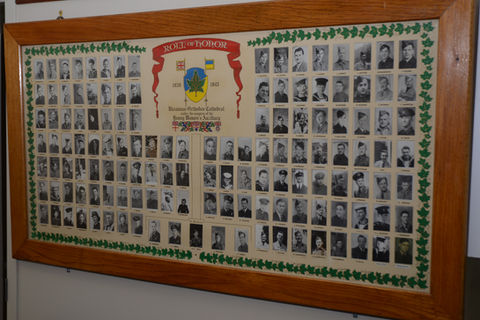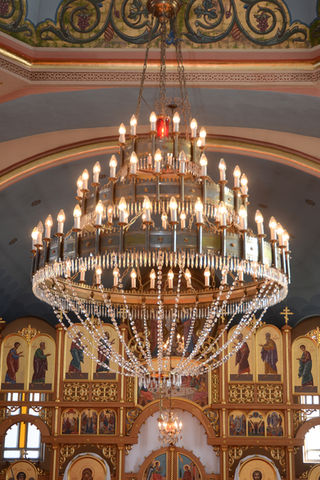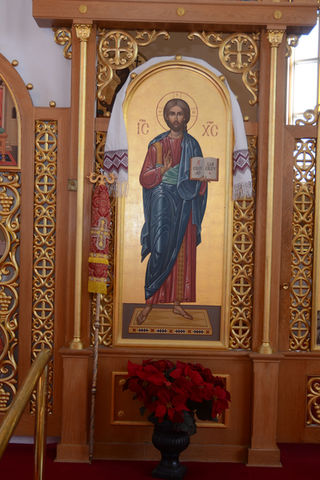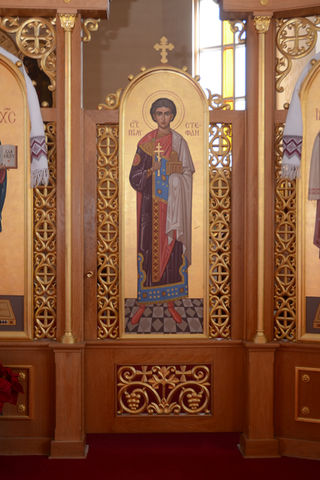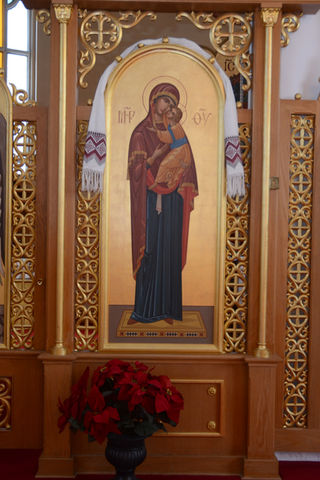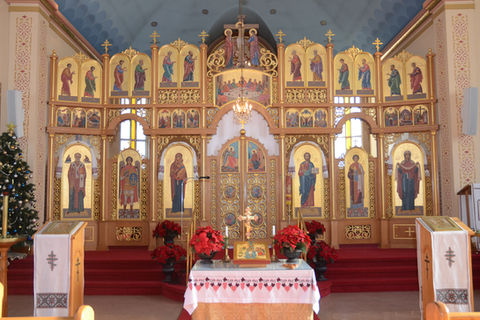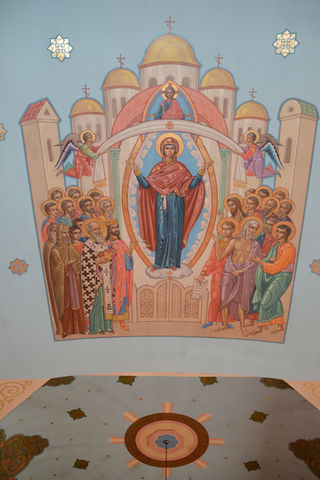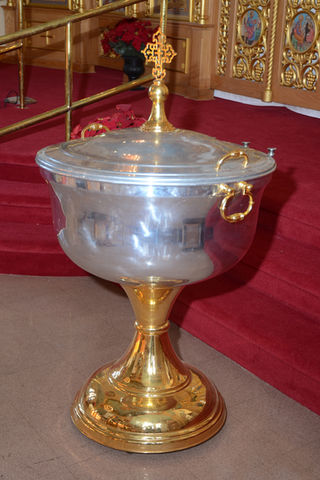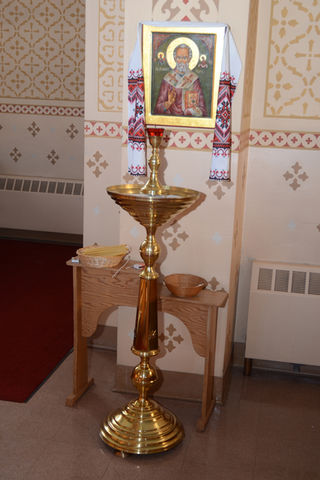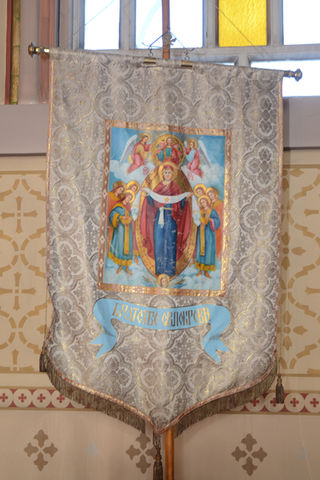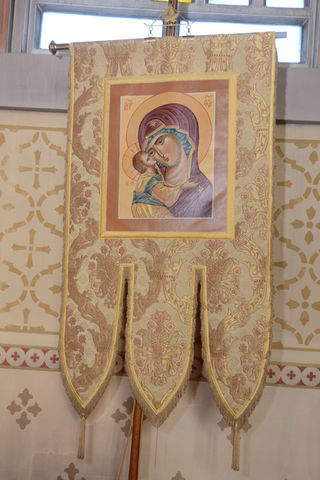St Mary the Protectress
Ukr Orthodox Cathedral


Ukrainian Orthodox Cathedral of St. Mary the Protectress
Sobor: A Historical Retrospective
Most people know it as ‘Sobor’.
Sobor is a Ukrainian word that means Cathedral. Right from its earliest days, the Ukrainian Orthodox Cathedral of St. Mary the Protectress was widely known in the Ukrainian community of Winnipeg and beyond as simply ‘Sobor’.
This year, the Sobor parish is celebrating its 93th Anniversary.
From its earliest days, the Sobor parish was a center of spiritual, cultural and educational activities in Winnipeg. The Sobor name evolved into a recognized brand that was synonymous with community activism and leadership and a style that was relevant, vibrant and at times edgy, but always involved in all spheres of Ukrainian community life.
For nine decades, Sobor has been characterized by its relationship with new immigrants, its roots with average working class families and its love for the Ukrainian heritage and religious traditions which go back centuries.
Sobor parishioners succeeded in building and maintaining a warm, friendly and open atmosphere embracing pioneers and new comers, Canadian-born and immigrants, young and old – everyone as one large Christian family.
The parish was established in 1925 on Burrows Avenue at Sinclair, one block west of Arlington in the heart of Winnipeg’s growing North End. At the time of its founding, the church property was on the northern and western boundary of the city. As new immigrants arrived from Ukraine, they settled and raised their families in this area of the city. The Sobor community was young, large and expanding. At its center was a strong Christian faith based on the eastern Orthodox traditions and its Ukrainian heritage.
The Sobor parish had 3 distinct periods of development; each period reflected the broad principles of inclusion and access for community members. The first phase was the building of the Church auditorium in 1925, which served as the place of worship on Sundays and Feast Days and as a community centre the remaining days of the week. The second phase was the construction of the actual church on top of the auditorium in 1952. And the third phase was the construction of the Millennium Villa for seniors in 1988, connected to the church building via an underground tunnel allowing for easy access by the residents of the senior’s home.
As the parish evolved over 9 decades, the community adapted to ever-changing demographics while maintaining the core values of the original founders.
As Sobor prepares for its Centennial in 2025, the parish determined that a key element is to showcase the involvement of all family members in the activities and life of the parish community. This is a very special and unique project. It will highlight the major milestone events, which were generated from within the parish community and have in some way influenced or impacted the broader provincial or national Ukrainian church community. While the focus is on the seminal events, the story in each case is based on how ordinary community members worked together to achieve a significant result. Each story underlines what can be achieved when people dedicate themselves to belong, contribute and work together. In so doing, they have defined a unique and special aspect of the nature and character of the Sobor community.
The Ukrainian Orthodox Church of Canada Foundation has supported a special Historical Outreach project largely to reach out to the several hundred 4th Wave Immigrants from Ukraine that have identified Sobor as their place of worship. This project will showcase a collection of multi-media digital presentations, each one depicting a major event that has contributed to the overall achievements of the Sobor Parish community from its inception in 1925. Sobor’s historical retrospective is divided into 7 distinct themes:
1. The Church - the Heart of the Sobor Parish Community
The original founders of Sobor numbered approximately 250 families in the early 1920’s. They were almost all new immigrants from Halychyna (Galicia) and Bukovyna provinces in western Ukraine. Most had jobs as casual labourers working long hours for 6, and often 7 days a week for meager daily wages. In spite of their difficult situations, they were dedicated enough organize a church congregation by starting a church choir. At first church services were held in other Christian churches. Then they began to work together to plan the church design of their own church. Once approved by the community, they committed to digging the basement foundation by hand, which was completed within 6 months. Constructing basement walls and a roof followed this. The new structure served as both the temple and a community center for the first 25 years. Within those walls, a very dynamic and comprehensive environment of spiritual, cultural and community development activities thrived, touching hundreds of families and their children.
2. Sobor as an Artistic and Cultural Center of Community Activities
Every month, the parish's Boyan Music Theatre group put on a different live theatrical production on the parish stage. In addition to being the spiritual leader of the parish, Father Petro Mayevsky also served as the cultural, artistic and educational leader for the community. He taught the church choir four complete liturgies and broadcast them from time to time over the radio. Sunday and Ukrainian schools were established and attracted many youth. The women’s group (UWAC) and youth organization (CYMK) were the heart of the cultural life of the parish. In addition, prominent cultural leaders - liturgical composer and conductor Oleksander Koshetz and the founder of Ukrainian dance in Canada Vasyl Avramenko - were rooted and active in Sobor parish life. Avramenko frequently used this parish and its organizations as a focal point for his activities in Winnipeg and western Canada from 1927 to the Second World War. William Kurelek’s family farmed in the Interlake and was active in the parish during the time William was a young student at the neighbouring Isaac Newton Public School. Kurelek went on to do his studies in Toronto and then become one of Canada’s most distinguished visual artists. In recent years cultural leaders and internationally renowned artists came from within our Parish, for example: Oleksandr and Olya Harkavyi – composer and musicians from Ukraine (and now our parish priest and his dobrodika); John Melnyk – accomplished pianist and teacher; Dmytro Bartoshuk – iconographer and his student Vera Senchuk – iconographer; Nyk Bielak – actor and performing artist – to name but a few.
3. The Parish’s Contribution to the Canadian War Effort
The Second World War was a pivotal period in Sobor’s history. The War significantly changed the Parish. It is documented that 110 young people, four of who were women, enlisted from the Sobor parish in the Canadian Military. Of these, five young men sacrificed their lives for Canada. When the war ended, very few of these young war veterans returned to this parish. While we know their names, very little else is known about them. Who were these young people? Where did they serve during the war and where did they go after the War? What do we know about them and their families? What has been the lasting impact of their service to our country and on the post-war developments of the Parish? What is known, however, is that their leaving to serve in Canada’s war effort permanently altered the demographics and character of the parish from what it had been prior to the war.
4. The Sobor Parish Sponsors Metropolitan Ilarion (Ohienko) to Canada
The circumstances around the Sobor parish coming together as one large family to sponsor and support Metropolitan Ilarion to Canada are dramatic and attest to the significant impact of the newly arrived 3rd Wave of Ukrainian immigrants to Winnipeg and to Sobor. Father Petro Mayevsky, who initiated the original request to the Government of Canada from Sobor to sponsor Metropolitan Ilarion to the parish, began the immigration process. It is remarkable that these new parishioners understood the academic, spiritual and political importance of Metropolitan Ilarion and advocated sponsoring him by their gifts and donations. All of this happened during a time when Sobor did not belong to the Ukrainian Orthodox Church of Canada (1937 to 1952). After his arrival to the parish, Metropolitan Ilarion was asked to become the Metropolitan of the UOCC and in accepting played a central role in having Sobor rejoin the UOCC in 1952. Father Hryhorij Metiuk joined Metropolitan Ilarion and served as Sobor’s parish priest during this the time. Years later Father Metiuk was consecrated as Bishop Andrew and served as the Metropolitan for the UOCC from 1975 to 1985. Sobor Parish, therefore, has provided the Ukrainian Orthodox Church of Canada two of its Metropolitans.
5. The Sobor Parish - its Seniors and its Youth
The St. Mary the Protectress Millennium Villa, or simply the Villa, is a 72-apartment senior’s residence that is located just east of Sobor and is linked via underground tunnel to the auditorium of the Cathedral. The conceptual planning for this project actually began in the early 1970’s when the Sobor Brotherhood first undertook raising funds to purchase properties on which the Villa was eventually built. Construction of the Villa began in 1988 and in 1989 it was officially opened. Over the past 30 years the residents of the Villa have added new dimensions to community life in the parish. The impact of the organization and the residents of the Villa who became active in the parish have contributed greatly to parish renewal. In the 20 years before the Villa project began, the Church Brotherhood raised enough funds to purchase the first 11 lots to enable project to proceed. The total value of the Brotherhood’s contribution to establish the Villa, both in land and in cash, was over $400,000. Over the years there were many volunteers, however, much credit goes to the leaders of this initiative - Michael Chaykowsky and Dmytro Duschak - who kept Brotherhood volunteers and the Sobor parishioners involved and supportive of the project for more than 2 decades to the point it became a reality. Duschak served as the Chair of the Villa Board for the first 25-year and for the past 5 years, long-standing board member Eugene Hyworon took over as the Board Chair. In 1992 the parish added an elevator on its south wall enabling Villa residents easy access to the Church in the comfort of not having to venture outdoors.
Parallel to the Villa, the parish’s leadership involvement in operating the Veselka Summer Camp in Gimli, Manitoba also had a large impact on the Sobor parish community. The annual summer camp program was renewed and the result was an increased participation of young people in Sobor’s cultural and educational programs, including CYMK and Sunday School and a resurgence of the Boyan Musical Theatre within the parish.
These initiatives contributed significantly to the parish's renewal and development in the period from 1990 to 2015.
6. The Sobor Parish’s Unique Relationship to the 1932-33 Holodomor
The parish includes a very large number of survivors of the 1932-33 Holodomor (famine genocide). As a result, for the past 15 years, the parish has assumed a leadership role in raising the awareness of the general public to the Holodomor tragedy. The parish’s activities began with a major conference that was covered by most of Canada’s national media. Since then, Sobor has commemorated the Holodomor tragedy annually by recognizing the survivors and having special programs dedicated to public awareness. Two of our parishioners – Valya Noseworthy and Irka Balan – have led the Holodomor activities in Winnipeg and Manitoba on behalf of the Ukrainian Canadian Congress – Manitoba Provincial Council including working closely with the Canadian Museum of Human Rights and facilitating the CMHR’s partnership relationship with the Holodomor Museum in Kyiv. The leadership of these two individuals has also impacted the national scene, as there are two new Holodomor Statues in Winnipeg placed in 2016 that are duplicates of the same statue of a young child at the Kyiv Holodomor Museum and are in addition to the first Holodomor monument that was erected in 1978 at City Hall. Of the two recent additions, one is on the grounds of the Manitoba Legislative Building and the other is in the CMHR.
7. The Sobor Parish and the 4th Wave of New Immigrants
90 years after the initial establishment of the Sobor parish by the new immigrants to Winnipeg of that time, the parish is experiencing another influx of new immigrants from Ukraine known as the 4th Wave. Each wave of immigration contributed different elements to the growth and development of the Sobor community. The parish is now welcoming families that are generally well educated, many that are Russian-speaking with families that are ethnically intermarried (Russian, Jewish, Romanian, Polish, Hungarian, Slovakian, Moldavian). In spite of these multi-national, intermarried family characteristics, this wave tends to be patriotic towards Ukraine and maintains close links to families and friends left behind. Having endured 70 years of atheistic rule of the communist regime, members of this wave arrive with a wide range of experiences related to their faith – some very knowledgeable and other with very little relations with the Church. Taken together, the members and faithful of Sobor have largely accepted these new families experimenting with different ways of engaging them so they feel welcome and are willing to integrate into the life of the Sobor community.
“To Serve God is to Serve People” Metropolitan Ilarion
Established on a foundation of worship, Christ-centeredness, and a spirit of service, the Sobor community was fortunate to have had 18 extraordinary parish priests who collectively provided the community with a broad range of leadership gifts. Complemented by excellent church choir directors and singers and served by dedicated and talented cantors and elders, the spiritual life in the parish was from the outset and continues to be today the bedrock on which the community functions.
What makes a parish a great community? Every parish wrestles with this question on a regular basis. Like other parishes, the Sobor community has been united in its faith and adherence to Ukrainian tradition. Over the years, the parish has demonstrated a certain willingness to ‘lead with an edge’. In spite of the fact the community was formed largely by immigrant families of average means, and has continued to be home to successive waves of immigrations from Ukraine, it regularly was capable of rising to the occasion, no matter how large or difficult the challenges. Whether it was sponsoring a Metropolitan to Winnipeg, or starting to raise funds for a senior’s residence more than 20 years before the project was even conceived, this community took on these projects fearlessly and with enthusiasm. When necessary, Sobor even challenged the legality of national Church administrative decisions when it was felt that they were not properly made. In recent years the parish has acquired some of the newest communications and Internet technologies and has incorporated this technology to enhance its educational, cultural and public awareness programs. When one looks back, it is a testament to the original founders such as the first parish priest Father Semen Sawchuk and the first parish leaders Vasyl Swystun and his wife Olya, who established the path on which many others have successfully followed. Together and over time their legacy has been significant.
Today as people look back over the 93 years, one thing is certain; most people in Winnipeg’s Ukrainian community know of the parish… and they know it as simply ‘Sobor’.
By Vasyl Balan with the assistance of a large number of Sobor parishioners. 2018
We believe together we can change the world and bring to our life more love, and values that will establish a foundation of prosperity for the next generations.
Our Mission
As one family in the Holy Trinity, we aim to grow spiritually, intellectually and culturally embracing the best, helping each other to be better, happier with every day of our extraordinary life.


